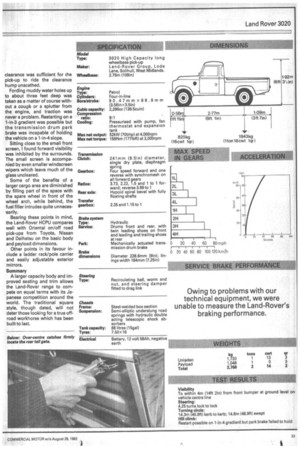A true, off-road work horse
Page 25

Page 26

Page 27

If you've noticed an error in this article please click here to report it so we can fix it.
Although not beyond criticism, the LandRover long-wheelbased high capacity pickup convinced Bill Brock that it can hold its own against Japanese competitors
LAND-ROVER's long-wheelbased 2.76m (109in)pick-up was introduced earlier this year. Two versions cater for gross vehicle weights of 2,710kg and 3,020kg. Our test vellicle, fitted with the high-load specification suspension, gives an increased payload of 25 per cent to 1.3 tonnes, while body capacity is bigger by about 45 per cent.
The high-capacity pick-up can be specified with any one of three power units, which include the 3.5-litre petrol unit as well as the 2.25-litre diesel or petrol engines. Fitted here, the four-cylinder petrol 2.25-litre engine falls in the middle of the power options rated at 52kW (70bhp) at 4,00Orpm.
The pick-up's load bed measures 2.01m (79in) long and 1.63m (64in) wide and gives a clearance of 0.92m (361n) between the squared-off wheel arches. Sturdy over-centre catches retain the wide tailgate which, when lowered, exposes the load platform height of the factory-fitted all-aluminium cargo body.
County trim is a move in the right direction away from the hot, sweaty, plastic seats which are still specified inside the cab as standard. The third, central seat can only be used over short distances or by small people. Restricted internal cab dimensions limit for and aft seat adjustment so that it was only just possible to obtain knee clearance in front of the trim. Unrubbared but large pedals give a good foot purchase for operation of both clutch and brake.
All Land-Rovers are equipped with two gear boxes. The main gearbox provides four synchromesh forward gears and one reverse and a transfer box doubles this up, adding a lower set of ratios.
A choice of two or four-wheel drive can be selected. For normal road use, drive to the rear axle is all that may be needed, while engagement of a dog clutch brings in the drive to the front axle for more severe driving conditions. Selection of the low ratio range of gears automatically engages four-wheel drive at the same time, but this operation should only be carried out while the vehicle is stationary, in neutral gear. Changing up from low to high range can be accomplished at any speed.
The transfer box also provides three pt-o drive alternatives for machinery mounted within the vehicle or at the rear. An auxiliary gear box can be mounted to the back of the transfer box to power hydraulic equipment when the centre pt-o is already taken up for other use.
The five-bearing four-cylinder engine is a recent development, producing maximum torque at relatively low speed to overcome problems associated with stationary running. A lower compression engine can run on fuel with an octane rating as low as 75. Ninety octane is suitable for the higher compression unit.
The engine had to work hard to keep the fully laden vehicle's speed up with that of other road users but overall journey times around CM's Thames Valley light vehicle route were about average. The steering was less than precise providing an incentive, if one were needed, to adhere strictly to the speed limits.
For this size of vehicle the ride was harsh and noise levels within the small cab were high. Although having slightly lower geared steering than the County station wagon, it remained heavy to manoeuvre, which was especially noticeable at low speed, and constant correction became tiring.
When the pick-up was unladen the steering was noticeably better and acceleration became quicker. Fuel consumption returns were 1 4.81it/1 0 Okm ( 1 9.1 4 mpg) against 17.71it/100km (15.92mpg) laden.
Free wheeling hubs may have improved these figures slightly but were not an option included here.
Off road, again with the load on board, the heavy duty front and rear suspension shock absorbers were made to work hard and hanging straps are fitted to limit axle movement. Fast cornering stability was improved using four-wheel drive but the suspension allowed a fair degree of roll. Even with a long 2.76m (109in) wheelbase, belly clearance was sufficient for the pick-up to ride the clearance hump unscathed.
Fording muddy water holes up to about three feet deep was taken as a matter of course without a cougig or a splutter from the engine, and traction was never a problem. Restarting on a 1-in-3 gradient was possible but the transmission drum park brake was incapable of holding the vehicle on a 1-in-4 slope.
Sitting close to the small front screen, I found forward visibility was inhibited by the surrounds. The small screen is accompanied by even smaller windscreen wipers which leave much of the glass uncleared.
Some of the benefits of a larger cargo area are diminished by filling part of the space with the spare wheel in front of the wheel arch, while behind, the fuel filler intrudes quite unnecessarily.
Bearing these points in mind, the Land-Rover HCPU compares well with Oriental on/off road pick-ups from Toyota, Nissan and Daihatsu on the basic body and payload dimensions.
Other points in its favour include a ladder rack/pole carrier and easily adjustable exterior mirrors.
Summary
A larger capacity body and improved seating and trim allows the Land-Rover range to compete on equal terms with its Japanese competition around the world. The traditional square style, though dated, will not deter those looking for a true offroad workhorse which has been built to last.








































